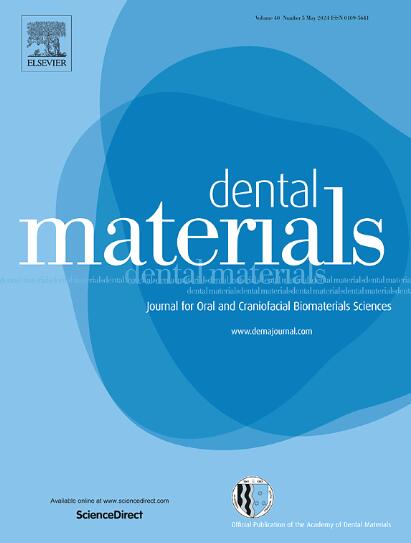Evaluation of a quadwave curing light compared to a dual-peak LED curing light
IF 4.6
1区 医学
Q1 DENTISTRY, ORAL SURGERY & MEDICINE
引用次数: 0
Abstract
Objective
To determine if the PinkWave (PW) light-curing unit (LCU) that emits red and infrared (IR) light as well as violet and blue light improves the depth of cure and degree of conversion (DC) of resin-based composites (RBCs).
Methods
The DC of RBCs at various distances was calculated from data collected at a rate of 13 Hz using attenuated total reflectance Fourier-transform infrared spectroscopy. To assess the contributions of the different wavelengths of light, optical filters were used to block the red and IR light from the PW. The depth of cure was also evaluated by photocuring RBC samples in both metal and plastic molds for 20 s at a 0 mm distance. The length of resin remaining was then measured and divided by 2. Starting from a baseline of 32 °C, the temperature rise during photocuring was measured in the plastic and metal rings reproducing the conditions used to measure the depth of cure and the DC respectively.
Results
In general, the PW produced greater depth of cure, however the use of metal molds greatly reduced this effect because the temperature increase was reduced. Increasing the distance by up to 4 mm from the light tip produced a significant increase in the DC for the RBCs photocured with the PW, but not for the G4. The wavelength of the blue peak (peaking at 473 nm) from the PW was longer compared to the control LCU (peaking at 448 nm). This 25 nm difference negatively affected the photocuring efficiency of some resins.
Significance
The internal optics and the additional red and IR wavelengths from the PW significantly increased the temperature in the RBCs and increased both depth of cure and the DC.
评估四波长固化灯与双峰 LED 固化灯的比较。
目的:探讨能发出红光、红外光以及紫光、蓝光的PinkWave光固化装置(LCU)是否能提高树脂基复合材料(rbc)的固化深度和转化率(DC)。方法:采用衰减全反射傅里叶变换红外光谱法,以13 Hz的速率采集数据,计算红细胞在不同距离上的直流电。为了评估不同波长光的贡献,我们使用滤光片来阻挡来自PW的红光和红外光。还通过在金属和塑料模具中以0 mm距离光固化RBC样品20 s来评估固化深度。然后测量剩余树脂的长度并除以2。从32°C的基线开始,测量了光固化过程中塑料环和金属环的温升,分别再现了用于测量固化深度和直流的条件。结果:一般来说,PW产生了更大的固化深度,然而使用金属模具大大降低了这种效果,因为温度升高减少了。从光尖增加4 mm的距离可以显著增加用PW光固化的红细胞的DC,但对于G4则没有。与对照LCU(448 nm)相比,PW的蓝色峰波长(473 nm)更长。这25 nm的差异对某些树脂的光固化效率产生了负面影响。意义:PW的内部光学和额外的红色和红外波长显著提高了红细胞的温度,增加了固化深度和直流。
本文章由计算机程序翻译,如有差异,请以英文原文为准。
求助全文
约1分钟内获得全文
求助全文
来源期刊

Dental Materials
工程技术-材料科学:生物材料
CiteScore
9.80
自引率
10.00%
发文量
290
审稿时长
67 days
期刊介绍:
Dental Materials publishes original research, review articles, and short communications.
Academy of Dental Materials members click here to register for free access to Dental Materials online.
The principal aim of Dental Materials is to promote rapid communication of scientific information between academia, industry, and the dental practitioner. Original Manuscripts on clinical and laboratory research of basic and applied character which focus on the properties or performance of dental materials or the reaction of host tissues to materials are given priority publication. Other acceptable topics include application technology in clinical dentistry and dental laboratory technology.
Comprehensive reviews and editorial commentaries on pertinent subjects will be considered.
 求助内容:
求助内容: 应助结果提醒方式:
应助结果提醒方式:


